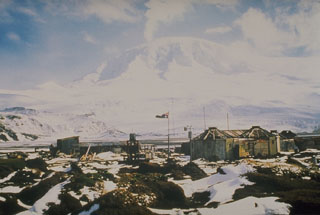Report on Heard (Australia) — December 2004
Bulletin of the Global Volcanism Network, vol. 29, no. 12 (December 2004)
Managing Editor: Richard Wunderman.
Heard (Australia) Thermal alerts indicate crater lake activity starting in June 2003 until June 2004
Please cite this report as:
Global Volcanism Program, 2004. Report on Heard (Australia) (Wunderman, R., ed.). Bulletin of the Global Volcanism Network, 29:12. Smithsonian Institution. https://doi.org/10.5479/si.GVP.BGVN200412-234010
Heard
Australia
53.106°S, 73.513°E; summit elev. 2745 m
All times are local (unless otherwise noted)
Infrared satellite data triggered MODVOLC thermal alerts between 24 May 2000 and 2 February 2001 (BGVN 28:01). A new series of alerts began on 9 June 2003, with frequent alerts continuing until 14 June 2004. The cloud-free ASTER imagery from June 2003 to June 2004 was examined, and although it does not offer very complete coverage of this new phase of activity, all the images contained very small anomalies (just a few pixels) in the central crater. This suggests that most of these alerts are due to increased activity at the lava lake, with no indication of lava flows. Also, all the 2003-2004 MODVOLC anomalies were 1-2 pixels (no elongate thermal anomalies), further suggesting that this is local central-vent activity.
Geological Summary. Heard Island on the Kerguelen Plateau in the southern Indian Ocean consists primarily of the emergent portion of two volcanic structures. The large glacier-covered composite basaltic-to-trachytic cone of Big Ben comprises most of the island, and the smaller Mt. Dixon lies at the NW tip of the island across a narrow isthmus. Little is known about the structure of Big Ben because of its extensive ice cover. The active Mawson Peak forms the island's high point and lies within a 5-6 km wide caldera breached to the SW side of Big Ben. Small satellitic scoria cones are mostly located on the northern coast. Several subglacial eruptions have been reported at this isolated volcano, but observations are infrequent and additional activity may have occurred.
Information Contacts: Matt Patrick, Luke Flynn, Harold Garbeil, Andy Harris, Eric Pilger, Glyn Williams-Jones, and Rob Wright, HIGP Thermal Alerts Team, Hawai'i Institute of Geophysics and Planetology (HIGP) / School of Ocean and Earth Science and Technology (SOEST), University of Hawai'i, 2525 Correa Road, Honolulu, HI 96822, USA (URL: http://modis.higp.hawaii.edu/).

